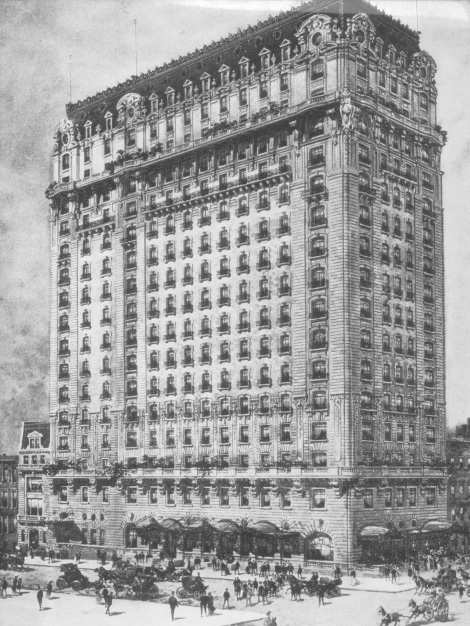John Jacob “Jack” Astor IV was the American equivalent of a crown prince. His blue-blooded mother, Caroline Webster Schermerhorn Astor, shaped and ruled the New York social elite in the Gilded Age. From his father’s side, he inherited a legendary name and a vast fortune based on Manhattan real estate. No family has ever owned so much of an American city as the Astors owned of New York: thousands of buildings, miles of riverfront property.
The family fortune – worth about $6 billion in today’s dollars – was split between Jack and his first cousin William Waldorf Astor, who spent it in suitably lavish style. The men lived in a world of dazzling marbled mansions, liveried servants, palatial country estates, summers at Newport, social intrigue, elaborate balls and yachts (Jack’s 230-footer could seat 60 in its dining saloon).
Although the two cousins had grown up in neighboring mansions on Fifth Avenue, they did not like each other. William, 16 years older, believed in high moral seriousness and looked down on his younger cousin as a dilettante who frittered away his time on thoroughbreds, motor cars, parties and other idle amusements. When their fathers died in the early 1890s, and the two young men took over management of their fathers’ business empires, each immediately tried to outshine the other by building competing luxury hotels.
William landed the first blow with the Waldorf. After his mother’s death, he knocked down the family mansion and started building the grandest hotel the world had ever seen – right next door to the home occupied by his cousin Jack and his aunt Caroline. Caroline was a small, plump, regal woman who hosted the city’s most exclusive parties and cotillions in the mansion’s magnificent ballroom. Eighteen household servants, in blue uniforms modeled on royal livery, served ten-course French dinners on solid-gold plates. Caroline wore so many diamonds that one guest described her as “a human chandelier” and another as “a dozen Tiffany cases personified”.
When William’s engineers and construction workers started to build the hotel, she was, naturally, furious, and moved out. The situation was little better when the hotel was completed in 1893. Not only did it dwarf her mansion and cast her garden into shade, but it gave her a view of a 13-story brick wall.
Jack was enraged. He was devoted to his domineering mother, who had pampered him thoroughly, aided by her four daughters. He commissioned an architect to build her a four-story French Renaissance chateau with the largest ballroom in the city, 30 blocks uptown on Fifth Avenue, then announced plans to demolish her former mansion and build a row of stables there, so the Waldorf would have horse dung to contend with.
When his advisers cooled him down, Jack came up with a more ambitious scheme: to build a much bigger hotel next door. Teams of lawyers and accountants went back and forth, and eventually a truce was inked, allowing the two hotels to be connected by corridors. The double-hotel was named the Waldorf-Astoria, and a provision in the contract allowed corridors to be sealed off if the truce collapsed.
With 1,000 rooms and a ballroom that could seat 1,500 people for a dinner dance, the Waldorf-Astoria was bigger than any royal palace in Europe. The central corridor was 300ft long, marbled and mirrored, and lined with glittering displays. It was known as Peacock Alley, and 25,000 people promenaded through it on a typical day. The novelist Henry James, not an easy man to impress, described the hotel as “a gorgeous golden blur… one of my few glimpses of perfect human felicity”.
The desire to build luxury hotels wasn’t anything new for the Astors. The founder of the dynasty, John Jacob Astor I, had erected the family’s first in 1836 to commemorate his name and his extraordinary wealth, which he had created from absolutely nothing.
The semi-literate butcher’s son from Germany had crossed the Atlantic in 1783, at the age of 20, and found a job cleaning rabbit and beaver pelts on the New York waterfront. By 1830 he had made so much money in the fur trade that he began to buy land on Manhattan Island, and when New York boomed into a world capital, Astor became the richest man in America and the nation’s first multi-millionaire.
Astutely, he never sold any of his land, but instead leased it to developers and collected rents from tenement buildings. The only thing he built with his own money was his grand luxury hotel, Astor House on Broadway. Hailed as “a marvel of the age”, it contained such wondrous innovations as indoor plumbing and running water, pumped around the building by a great steam engine in the basement. There was a French chef with 12 cooks and 60 waiters, and a new menu printed every day on an in-house printing press. When Astor died in 1848, his hotel was widely acknowledged as the best in the world (although at the close of the century it was on its last legs, and was demolished soon afterwards).
Jack Astor was the founder’s great-grandson, and he called himself Colonel Astor after commanding his own artillery regiment in the Spanish-American War. Tall, thin and debonair, if slightly gangling and awkward, he married one of the great beauties of the American aristocracy, Ava Lowle Willing of Philadelphia. But it was an arranged marriage, and it turned out unhappily. Jack took refuge in his yacht, as his father had done before him, the many gentlemen’s clubs he belonged to, the corporate boards he sat on almost by birthright, his collection of 60 motor cars and, increasingly, his laboratory.
He was fascinated by machines, electricity and the future, and he invented a new brake for bicycles, a marine turbine engine and a “pneumatic road-improver” that removed dirt from road surfaces and won first prize at the Chicago World’s Fair. He also wrote a science fiction novel called A Journey in Other Worlds, which predicted space travel, global warming, melting polar ice caps, television and genetic engineering. “He had imagination and a mystical side, but he was engineering-orientated really, and a damn good inventor,” says his 90-year-old grandson Ivan Obolensky, whose father, Serge Obolensky, a White Russian prince, married Ava Astor, Jack’s daughter, and was appointed to the board of The St. Regis New York. “He was the richest man on the Titanic, and if he’d have lived longer, he’d have died even richer. He was getting into torpedo designs and some really advanced stuff. The air conditioning system he designed for The St. Regis was a brilliant scheme.”
Having built the Waldorf-Astoria, the cousins continued to expand their hotel empire by constructing dueling hotels on opposite sides of Times Square. William had started with the 17-story New Netherland. When Jack started designing the $6 million St. Regis, he decided it would be 18 stories high: the tallest in the world.
Named after a vacation resort in upstate New York popular with Manhattan’s power elite, The St. Regis was his masterpiece, reflecting both his love of splendor and his passion for innovation. The limestone exterior featured decorative wrought-iron balconies and elaborately carved garlands, in the fashionable Beaux Arts Parisian style. The interiors, of creamy Caen stone and Istrian marble, were designed in a style inspired by the palace of Versailles, with ornate woodcarvings, antique furniture and Flemish tapestries.
But hidden inside the bowels of the building was a labyrinthine network of ducts, channels, tubes, wires and pipes that Astor designed himself. There were mail chutes on every floor, telephones in every room, and outlets for dust-sucking machines connected to a big central vacuum. Adjustable thermostats in every room accessed his novel heating, cooling and ventilation system that “purified” the air by forcing it into the rooms through cheesecloth filters, and cooled it with fans blowing over melting, evaporating ice. It combined American invention and European opulence, making it, as Astor had hoped, the finest hotel of its age.
Like his first hotel, this one, on Fifth Avenue and 55th Street, caused Astor big trouble with the neighbors. This was a very exclusive residential area known as Vanderbilt Row, and its tycoons and socialites did not want their mansions towered over by an 18-story skyscraper. Led by William Rockefeller, they blocked the hotel’s application for a bar licence, on the grounds that it lay within 200 feet of a church and so violated the state liquor law, and boycotted any events held there. The battle went on for two years, until an Astor-friendly senator changed the law to exempt large hotels.
When Prince Sadanaru Fashimi of Japan stayed at The St. Regis for two weeks, Vanderbilt Row was impressed and opposition started to fade. Soon after, Mr. and Mrs. William Vanderbilt announced that they would move into the hotel for the winter, and in the following years, Marlene Dietrich and Salvador Dalí would live at The St. Regis on a seasonal basis. Of all the hotel buildings commissioned by the Astors in New York, only The St. Regis still remains. Now modernized and refurbished, but fully in keeping with its original style and splendor, it is Jack Astor’s greatest legacy and the cornerstone of the St. Regis group.
Although Astor’s hotel empire was flourishing, his personal life was less successful. A year after his mother, Caroline, died in 1908, his wife, Ava, divorced him on grounds of adultery – to the horror of the high Episcopalian ministers in his family church. With his unhappy marriage finally behind him, though, Jack gained a new lease on life. He started to entertain lavishly, and accepted more invitations to society weddings and costume balls. In the summer of 1910, he met an attractive 17-year-old debutante called Madeleine Talmage Force, at Bar Harbor, Maine, and they fell madly in love.
The entire nation was shocked when their marriage was announced. No Episcopalian clergyman would perform the service and, after a frantic search, Astor found a Congregationalist minister who was willing to do it for $1,000 cash. The couple exchanged vows at Beechwood, the Astors’ summer mansion in Newport, and many guests showed their disapproval by staying away. “I’m afraid Madeleine was the Scarlet Letter in our family,” says Obolensky. “She came right out of the blue.”
The newlyweds spent the winter of 1911-12 in Europe and Egypt, but when Madeleine discovered she was pregnant, they decided to travel home in grand style. They booked a luxury suite for the maiden voyage of the biggest, most impressive ocean liner that had ever been built. With Jack’s valet, Madeleine’s lady maid and private nurse, and an Airedale terrier named Kitty, they boarded RMS Titanic at Cherbourg as the sun set on April 10, 1912.
Four nights later, after feasting on caviar, lobster, Egyptian quail and plovers’ eggs, as the string orchestra played Puccini and Tchaikovsky, the gentlemen in first class escorted their ladies down the grand staircase to their suites. At 11.40pm, there was a sudden violent shaking that lasted no longer than a minute. As the iceberg floated away, the ship sailed smoothly again, but fatal damage had been done, and Captain Edward Smith ordered the lifeboats to be prepared and all passengers on deck.
Jack Astor helped Madeleine into a cork lifejacket, showed her to a lifeboat, and inquired if he might join her since she was in “a delicate condition”. The lifeboats were for women and children only, he was told, and he accepted it gracefully. “The sea is calm,” he told her. “You’ll be alright. You’re in good hands. I’ll see you in the morning.”
Madeleine survived and gave birth to a son, but Jack Astor died: probably killed by a falling smokestack as the Titanic went down nose-first with her stern in the air. His body, clad in a lifejacket and a blue serge suit, with $2,500 in cash and a gold watch in the pockets, was found floating a week later by a passing steamer.
Thousands of people mourned the colonel as his coffin passed through the streets of New York, and songs were composed about him and legends multiplied. He sank with the ship while waving farewell to his bride, people said.
In the film Titanic, he drowns clutching on to his money like a miser, an inaccurate and unfair portrayal of a generous soul, says Ivan Obolensky, who was born three years after his grandfather’s death. “He was only 47 and really coming into himself. It was a terrible loss to our family, although we were too stoic to talk about it. He was a good, steady human being, benign and honorable, and disappeared in his prime.”
Carousel images courtesy of Mary Evans Picture Library, Getty Images, Corbis
Behind the wheel of one of his 60-strong
collection of cars in 1903 (Photo: Corbis)
The opulent Louis XVI-style foyer in 1904,
the year of The St. Regis’ opening
John Jacob Astor IV dressed as Henry IV of France for the lavish
Bradley-Martin Ball, held on February 10, 1897 at the Waldorf Hotel,
which had been built by his cousin William (Photo: Corbis)






